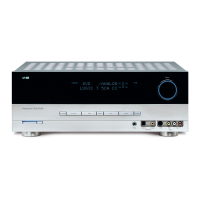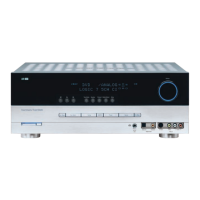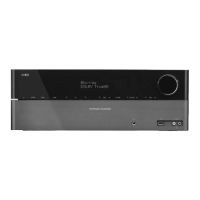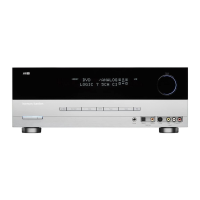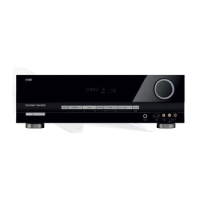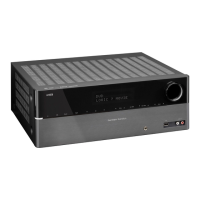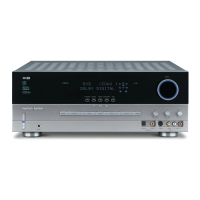and music, may prefer that different bass management
be used when listening to music through a CD player
as opposed to a movie from a DVD player, VCR or
c
able/satellite set-top. Also, you may wish to activate
o
r deactivate certain speakers for some sources. For
example, when listening to music CDs, you may wish
to have only the front left and right speakers active,
or for watching TV, you may wish to deactivate the
s
urround back speakers in favor of a 5.1-channel
configuration.
If you wish to customize the speaker settings for
e
ach input, make certain that the
›
c
ursor is on the
BASS
M
GR
line
,
and press the
‹
/
›
Buttons o
so that INDEPENDENT appears. When this
setting is entered by exiting the menu, you may need
to go back to the
INPUT menu to select another
input, and then return to this menu page again to
change the settings for that input. Repeat the proce-
dure for any input where you wish to have a different
set of speaker configurations.
NOTE: When the INDEPENDENT setting is
activated, you may assign different speaker size set-
tings to each input to accommodate different bass
management settings that match your preferences
with the type of program material normally used with a
particular source (for example, when movies are played
from DVD and music from a CD player). However, the
actual speaker crossover settings are set only once and
do not change with the input selection. The reason is
that, while bass management preferences may vary,
the actual speakers remain the same, regardless of the
bass-management and redirection settings.
Speaker Crossover Settings
When all initial speaker “size” settings have been
made
,
you now have the option to take advantage of
the AVR 140’s Quadruple Crossover system, which
allows individual crossover settings to be made for
each speaker grouping.
In systems where full-range or
tower speakers are used for the front soundstage or
where different brands or models are in use at the
various speaker positions, this feature allows you to
customize the bass management and redirection cir-
cuits with a precision not previously possible.
The low-frequency crossover setting is determined by
the design of your speakers
.
Depending on the design
and driver complement of your speakers, it is usually
the lowest possible frequency the speaker is capable
of reproducing. Before making any changes to the
settings for the crossover point,
we suggest that you
find the lowest frequency for the speakers in each of
the three groupings, front left/right, center and sur-
rounds
, by looking at the specifications page of each
speakers’ owner’s manual, or by contacting your dealer
or the manufacturer
’
s customer service department or
Web site. You will need this figure to accurately config-
ure the next group of settings.
T
he factory default setting for all speaker positions is
100Hz. If that setting is acceptable for all channels,
then no adjustments are needed and you may skip
this section. However, if you wish to change one of the
s
ettings, proceed to the
S
PEAKER X-OVER
submenu by pressing the ¤ Button n until the ›
cursor is pointing to the BACK TO MANUAL
SETUP
line of the SPEAKER SIZE sub-
menu, and then pressing the
Set Button p so that
t
he
M
ANUAL SETUP
s
ubmenu appears. Then
press the
¤ Button n until the › cursor is point
-
ing to the
SPEAKER X-OVER line. Press the
Set Button p, and the SPEAKER X-OVER
submenu will appear (see Figure 9).
Figure 9
To change the setting for any of the four speaker
groups, press the
⁄
/
¤
Buttons n until the cursor
is next to the line where you wish to make a change,
and then press the
‹
/
›
Buttons o until the desired
setting appears. The available choices that determine
at which point low-frequency information will be sent
to the subwoofer, rather than to the main speaker
channel,
are 40Hz,
60Hz, 80Hz,
100Hz,
120Hz,
150Hz and 200Hz. Pick the choice that is identical to
the information for the speakers, or if an exact match
is not possible, pick the closest choice that is ABOVE
the speaker
’
s low-frequency limit or crossover point to
avoid the creation of a low-frequency
“hole” where
your system will have no bass information.
NOTE: In cases where LARGE is selected as the
front channel speaker option and
LFE+L/R is
selected as the
subwoofer
option,
the front channel
sound information below the setting shown will be
sent BOTH to the front channel speakers and to
the subwoofer.
The crossover settings for the Left/Right, Center,
Surround and Surround Back speakers are used to
determine where bass information is sent when it is
derived from the main channels of a source.
The setting for the menu line shown as
LFE is used
to impose a low-pass filter point for the infor
mation in
the Low Frequency Effects (LFE) channel that is a part
of Dolby Digital- and DTS-encoded source material.
While the LFE channel, which is the “.1” you see in
surround sound designations, is restricted to low fre-
quency sounds, some mixes may include information
t
hat is higher in frequency than your subwoofer is
c
apable of reproducing. To prevent unwanted sounds
from being sent to subwoofers that cannot handle
them and which do not have a built-in low-pass filter,
the
LFE option line enables you to select a setting
f
or the low-pass filter that is part of the subwoofer
feed from the LFE channel. The settings available are
the same as those tied to any one of the four available
speaker positions on this submenu. We recommend
t
hat you use the frequency that is just slightly higher
than the upper capability limit of your subwoofer, as
shown in the sub’s Owner’s Manual.
When the cursor is on the
LFE line, press the ‹/›
Buttons o to choose the appropriate setting.
When all speaker selections have been made, press
the
¤
Button n and then the Set Button p to
return to the
MANUAL SETUP submenu.
Delay Settings
Due to the different distances between the listening
position for the front channel speakers and the sur-
round speakers, the amount of time it takes for sound
to reach your ears from the front versus surround
speakers differs. You may compensate for this differ-
ence through the use of the delay settings to adjust
the timing for the speaker placement and acoustic
conditions in your listening room or home theater.
The AVR 140’s advanced software enables you to
quickly and easily set delay times without having to
calculate them using a complex for
mula. All you need
to do is measure the approximate distance between
your listening position and each of the speakers in
your system.
When you enter those distances into
the AVR’s memory as shown below, the AVR’s micro-
processor calculates the proper delay time
.
The meas-
urements need not be accurate to the inch, as the
system is designed to accommodate a typical listening
area rather than require the precise measurement to
one “sweet spot”
position.
Due to the differences in the way each surround
mode operates, the delay settings must be established
individually for each surround mode. However, once
the delay settings are configured for the version of the
surround mode with the most channels, they need not
be entered again for a version of that mode with fewer
channels. For example, once the delay settings are
established for Dolby Pro Logic IIx – Movie, they will
be carried over to Dolby Pro Logic II – Movie mode.
However,
you will need to enter the
delay settings
sep-
arately for each variant mode, such as Dolby Pro
Logic IIx – Music, Dolby Pro Logic IIx – Game, Dolby
Pro Logic, Dolby 3 Stereo and Dolby Digital EX.
* SPEAKER X-OVER *
L
EFT/RIGHT:100HZ
CENTER :100HZ
SURROUND :100HZ
SURR BACK :100HZ
LFE :LEFT/RIGHT
BASS MGR :GLOBAL
BACK TO MANUAL SETUP
22 SYSTEM CONFIGURATION22 SYSTEM CONFIGURATION
SYSTEM CONFIGURATIONSYSTEM CONFIGURATION
AVR 140 OM 3/29/06 3:45 PM Page 22
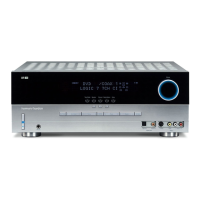
